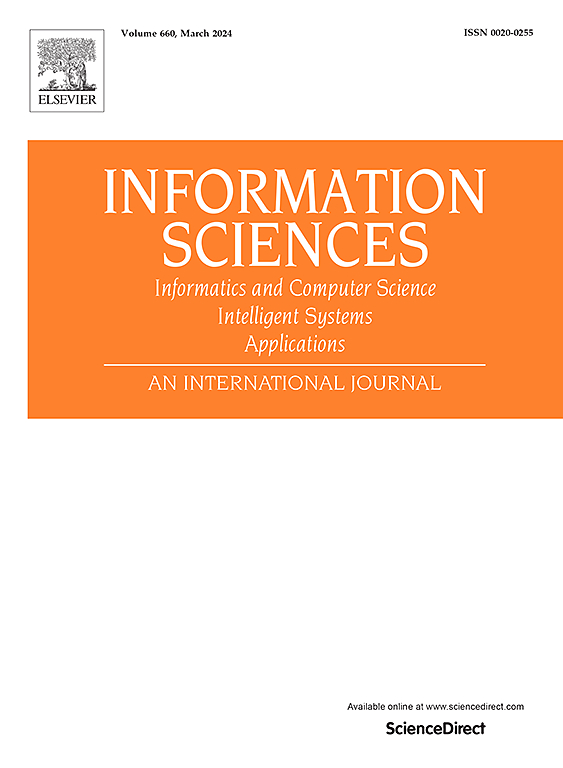CF2M-Net:视频异常检测的跨特征融合和内存约束网络
IF 6.8
1区 计算机科学
0 COMPUTER SCIENCE, INFORMATION SYSTEMS
引用次数: 0
摘要
视频异常检测(VAD)旨在自动识别监控视频中与正常模式明显不同的异常事件。大多数现有的方法都是学习正态特征的时空分布,并将偏差检测为异常。通常,它们使用自动编码器来独立学习外观和运动特征,但这种单独的学习限制了它们在现实场景中相互关系的利用。为了通过捕获特征相互关系来增强正常模式的表示,我们提出了一种用于VAD的跨特征融合和记忆约束网络(CF2M-Net)。具体而言,受多模态融合中交叉注意表征能力的启发,我们设计了一个交叉注意和记忆约束(CM)模块,通过运动信息丰富外观特征。为了防止对异常事件的过拟合,内存约束模块进一步将融合特征约束在正常模式分布内。我们设计了一个注意力融合(AF)解码器来预测更接近正态分布的正态特征,增强它们与异常的可分离性。CF2M-Net通过特征融合和内存约束对外观和运动进行联合建模,为异常检测提供了更具判别性的正态表示。在三个基准数据集上的实验评估表明,CF2M-Net的性能与主流方法相当。此外,详细的评价表明了基于正态表示的外观-运动融合特征对VAD的有效性。本文章由计算机程序翻译,如有差异,请以英文原文为准。
CF2M-Net: Cross-feature fusion and memory-constraint network for video anomaly detection
Video anomaly detection (VAD) aims to automatically identify anomalous events in surveillance videos that are significantly different from the normal pattern. Most existing methods learn the spatial-temporal distribution of normal features and detect deviations as anomalies. Typically, they employ autoencoders to independently learn appearance and motion features, but this separate learning limits the exploitation of their interrelation in real-world scenarios. To enhance the representation of normal patterns by capturing feature interrelation, we propose a cross-feature fusion and memory-constraint network (CF2M-Net) for VAD. Specifically, inspired by the representational ability of cross-attention in multimodal fusion, we design a cross-attention and memory-constraint (CM) module to enrich appearance features with motion information. To prevent overfitting to anomalous events, the memory-constraint module further constrains fused features within the distribution of normal patterns. We design an attention fusion (AF) decoder to predict normal features closer to the normal distribution, enhancing their separability from anomalies. By jointly modeling appearance and motion through feature fusion and memory constraints, CF2M-Net provides more discriminative normal representations for anomaly detection. Experimental evaluations on three benchmark datasets show that the CF2M-Net performs comparably with leading approaches. Moreover, the detailed evaluations indicate the effectiveness of normal representation based appearance-motion fusion features for VAD.
求助全文
通过发布文献求助,成功后即可免费获取论文全文。
去求助
来源期刊

Information Sciences
工程技术-计算机:信息系统
CiteScore
14.00
自引率
17.30%
发文量
1322
审稿时长
10.4 months
期刊介绍:
Informatics and Computer Science Intelligent Systems Applications is an esteemed international journal that focuses on publishing original and creative research findings in the field of information sciences. We also feature a limited number of timely tutorial and surveying contributions.
Our journal aims to cater to a diverse audience, including researchers, developers, managers, strategic planners, graduate students, and anyone interested in staying up-to-date with cutting-edge research in information science, knowledge engineering, and intelligent systems. While readers are expected to share a common interest in information science, they come from varying backgrounds such as engineering, mathematics, statistics, physics, computer science, cell biology, molecular biology, management science, cognitive science, neurobiology, behavioral sciences, and biochemistry.
 求助内容:
求助内容: 应助结果提醒方式:
应助结果提醒方式:


